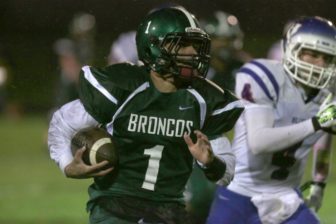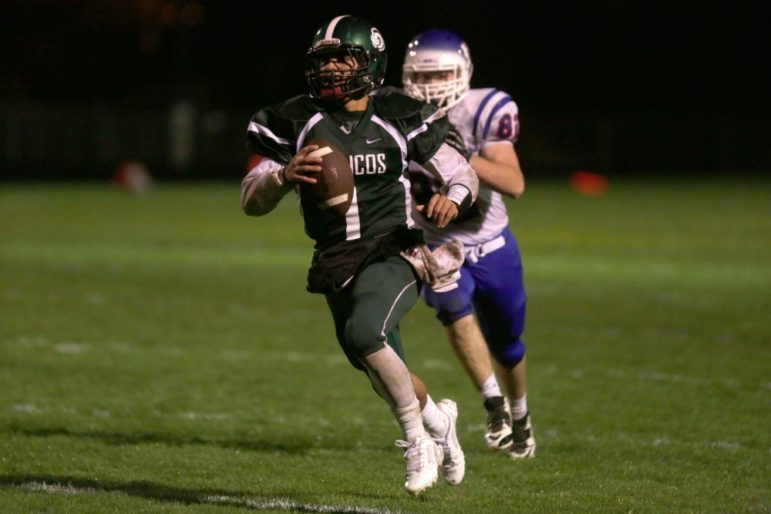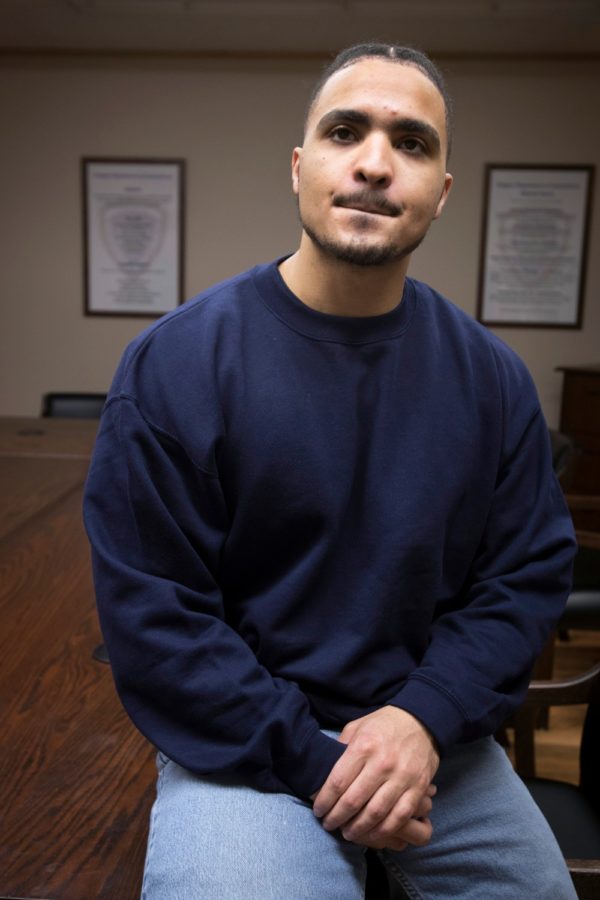Jonathan Boland jogged onto the Parkrose High football field, making his varsity debut in September 2011, proud that he was among the few freshmen talented enough to play with the upperclassmen. He wore a medium-size jersey and a thin mustache, still going through puberty and uneasy about how much older everyone else was.
“It was a scary time in my life. I was 14 years old playing dudes that were signed to Oregon,” Boland said, referring to this dude: Brett Bafaro, 6-foot-2, 220-pound senior linebacker with Hillsboro’s Liberty High School, who would go on to play for the Ducks. In a 2012 interview with The Oregonian, asked about why he preferred defense to offense, he replied, “I prefer to hit people in the mouth.”
Boland had the fear. A boyish aversion to getting hit in the mouth. The game was expected to be a blowout. Bafaro’s Liberty Falcons were contending for the state championship, while Boland’s Parkrose High Broncos were not. In Oregon, the same schools tend to see one another in the state playoffs year after year, while the same schools at the bottom, like families in the Middle Ages, linger there for generations. The previous year marked the first time Parkrose had made the playoffs in over two decades. Boland buckled his chin strap and got limber, aware he and his teammates were David playing Goliath.
He was sent out to play safety.
On one series, Liberty handed off the ball to their running back. Bafaro, who lined up as fullback on offense, ran escort. He had been laying Parkrose defenders supine all game, and on this play, only Boland was left to prevent a touchdown. He watched as the running back galloped toward him, like a centaur holding a football. Inside, he panicked. “I was more focused on not getting hit than delivering the hits,” he said. He dove for the legs. The Liberty running back barely slowed, stepping around him, with the contempt some people have for beggars.
Boland remembers himself, then, as an ankle biter, someone who wraps their arms around the legs of another player to tackle, rather than initiating full contact. He didn’t have the appetite, at the time, to hit people in the mouth.
On another series he kept his eyes focused on the quarterback, trying to anticipate the play. He took note of the quarterback’s posture, the way his shoulders were angled. He went where they pointed. In football parlance he was “declaring,” abandoning the rest of the field to dedicate himself to one receiver. If he were successful, he wouldn’t need to tackle anyone. If he misread the quarterback, he might leave open another receiver. But he’d guessed right. He leaped into the air and intercepted the ball. He was in disbelief. His teammates rushed to congratulate him. He jogged off the field, hearing his name on the loudspeakers, his chest swelling with pride.

During his four years at Parkrose High, Jonathan Boland passed or 6,450 yards and rushed for another 3,000.
Parkrose would lose that game, 21-14, nearly upsetting the championship contenders. And in that moment, with his mother cheering in the stands and upperclassmen patting him on the helmet, Boland discovered something.
“It was magical,” he said.
It was one game in a second-tier conference, in a city with more enthusiasm for soccer than football, but he found meaning. By the time he returned to the bench, he already was chasing the feeling again. “It triggered something in me to push me to go to college for football.” Boland said, “After that first game I said yes. I told myself, ‘I must get a scholarship to play football in college, anywhere.’”
Boland would lead the team in interceptions that year, earning honorable mention all-Northwest Oregon Conference.
Five years later, Renee Boland, hears a knock on the door. She opens it and finds her son standing there. “I didn’t even know who this kid was,” she said later. “He just looked like this wild person who had not slept in days.”
Jonathan, her youngest son, the one to be on ESPN, to land their family name in the newspaper, seems broken. “He just came in, sat down on the couch and started crying very hard,” Renee said.
She asks him what’s wrong.
“I don’t know,” he says. Then he reverses himself. “Mom just help me, just help me right now. I messed my life up.” He confesses some things he’d done.
The next day, in another part of town, a new case lands on Detective Darren Posey’s desk.
The case tells the story of a boy, a sport and the Faustian bargain between them. Jonathan Boland wanted everything: money, fame and a life beyond his blue-collar Portland neighborhood. Football wanted everything from him: a willingness to sacrifice his own blood for sport. His is the story of who got what. And the role that concussions may play when athletes betray themselves.
****
The Parkrose School District began as one schoolhouse on Northeast 122nd Avenue and Sandy Boulevard, in 1885, and for a hundred years was mostly left alone. Then Portland grew. Parkrose was annexed beginning in 1983, and as one resident put it in “The Wheel Keeps Turning: An Oral History of Parkrose,” “I thought that it was more or less the demise of neighborliness out here and we were subject to all the Portland problems.”
Gentrification refugees fleeing rising rents arrived in Parkrose. Over time, some residents stayed. Some left. Now the neighborhood is a kind of antechamber to the unbranded cities beyond, where the discards of Portlandia are at home. Among students in the district, 73 percent qualify for free or reduced-price lunch. And while Portland is one of the whitest big cities in America, students of color make up 70 percent of the population at Parkrose High. It is a neighborhood at odds with the rest of Portland, producing the kind of friction that could make young men want to hit things.
Jonathan Boland came to football in sixth grade via the Portland Police, who sponsored a youth league to divert at-risk kids into team sports. One might expect the local high school team to be a natural fit for youth like him, but even The Mid County Memo, a newsletter circulated monthly in Parkrose, wrote of the team, “has been a running joke for nearly two decades.” Tim Price, the school’s head coach at the time, told the Memo, “The kids don’t want to come up here and play.”
If football coaches gave at-risk youth meaning and a license to hit guys in the mouth, they weren’t the only ones recruiting. Parkrose gangs drew from the same well. The high school had trouble just maintaining a varsity roster. It didn’t help that some private schools went into neighborhoods like Parkrose and tried poaching the best athletes. The pitch to a blue-collar family was simple: give your son, possibly your daughter, over to our program in exchange for a better education. The street gangs and prep-school recruiters left Parkrose with an anemic roster.
Boland changed that, for a time.
A week after the Liberty game, following a punishing defeat at Putnam High, Boland limped to class, bruised from the game.
“My neck area, my trapezoids, my shoulders, they were banged up, and I never been banged up after a football game,” he said.
Students approached him, congratulating him on being named the starting quarterback in the upcoming contest against Wilson High. He remembers hearing things like “Congrats, bro.”
He thanked them and tried to play it cool. The senior quarterback, Zach Abney, needed to sit out for a week from an ankle injury and the sophomore backup quarterback was snubbed. All eyes were on the freshman now.
The fear returned. “You could tell I was nervous,” Boland said. The game plan against Wilson called for slant routes, simple plays meant to ease him into the quarterback role. But he kept throwing the ball into the ground. Pass rushers were getting in his face and forcing him into bad decisions. The backup quarterback sat on the bench, looking on, and Boland knew he couldn’t keep throwing balls away.

Then he discovered something new about how to play quarterback. He clapped his hands and called for the ball. Pass rushers came at him. This time, though, rather than throw the ball away, he did one of the most instinctive things one can do when being chased: he ran.
Boland slipped past the defensive line, maneuvering like a motorcycle in traffic. First down. He broke more than 20 yards, as he remembers, then returned to the huddle. The upperclassmen patted him on the helmet. He heard someone say, “Good play, bro.” One of them told him to “do it again.” So he did. Another first down.
By avoiding contact, the Parkrose team found itself surviving in games. Big, lumbering defensive ends came around the edge, looking for Boland, trying to get their arms around him, wrangle him in the backfield. But he had different ideas, like a chicken taking it upon himself to be cage-free. He made highlight reels from these encounters. Broken plays where he improvised, shimmying out of a tackle, bobbing and weaving for the camera. He was reducing the game into a kind of freeze tag, seeing how far he could get before they touched him.
When Boland took over as starting quarterback a year later, Parkrose’s score per game doubled from an average of 14 to 28 points. But as word spread of his talents, he no longer would walk away from plays unscathed. Once coaches knew Parkrose had a mobile quarterback, they could plan for it: set edges and contain, dare him to throw, force Parkrose to play football the way everyone else played. If Boland’s Parkrose rise was new money, on the night of Oct. 5, 2012, they met the old money: Sherwood High School.
Tim Curran, publisher of the Memo, described the team this way: “Powerhouse, juggernaut, unstoppable, mostly white kids. Loved kicking the crap out of inner-city schools.” That night, Curran recalled, the air was charged. “The racial thing is just a tinge, but,” Curran said, “it’s just a little bit different, you know, when they take down the cocky black quarterback.
“They did try (to) hurt that kid,” Curran continued. They were out to punish. Because they knew if you got Boland out of the game, it’s over. He was that team.”
Boland remembers rolling out, looking for Marshawn Edwards, his best wide receiver and best friend. A Sherwood defender was after him. So Boland made for the sidelines, hoping Edwards could get open, but quickly approaching the edge of bounds. He threw the ball into double coverage, as he got hit from behind.
Boland remembers being on the ground and hearing a ringing. He remembers bright flashes, like somebody was flickering the lights off and on. He stood up and had blurry vision. His team was walking off the field — he learned later that he had thrown an interception. In the moment, he thought to himself, “This feels different than a regular headache.”
If you would have asked him if he thought that headache was a concussion? “I would have said concussions aren’t real.”
“OK. Um, Jon, this is, this has been my question though,” Detective Posey says, sitting across from Boland years later. “When I first realized it was you, and what was going on, it’s like, ‘Why?’”
“I don’t know that,” Boland replied.
****
Even the commissioner of the NFL, Roger Goodell, a man impressive in his ability to inspire more boos from crowds than the visiting team, doesn’t doubt that concussions are real. There is no debate on the existence of concussions.
But Boland was still thinking, in 2012, of head injuries coded in the euphemism of getting your bell rung. Today it is less common for coaches to repeat those phrases, convinced that such language makes it easier to ignore a serious medical condition, or just aware that self-preservation demands they play along.

Jonathan Boland now suspects that concussions played a role in his life’s unraveling. But he says that if you’d have asked him about the impact of brain injuries when he was in high school, “I would have said concussions aren’t real.”
But even a sincere effort to explain concussions, beginning with the definition of the word itself, is more challenging than it seems. Try it. You may find yourself listing causes (blow to the head) or symptoms (passing out, seeing stars). But what exactly is a concussion?
The common image is a brain bumping against the inside of the skull and bruising. That understanding creates the kind of danger for athletes that “luck” creates for gamblers, a narrative that allows a person to tolerate more risk than he might otherwise.
There isn’t any bruise to observe. A concussion doesn’t show up on any brain scan. We can’t see it, but we know it exists. Much like a black hole’s gravity reins in the stars around it, a concussion creates a constellation of symptoms that prove a medical event has taken place.
The medical event is this: a specific threshold of G-force visited on the head, the slight increase in push that’s maybe the difference between fun and tragedy on the playground swings.
The G-force causes the brain to whiplash inside the skull. The neural connections that make up the brain stretch. At the microscopic level, there is a tug of war between two individual neurons in different states of inertia. The link between them, called the axon, stretches until it rips apart from the stress.
What’s lost could have been one tiny part of a mosaic that makes up a memory from childhood. But it gets worse. The broken axons, like a busted gas line, secrete chemicals that aren’t meant to be out in the open, choking the neurons around it — more childhood memories — spreading a small cloud of death, until the image of a nice thing your mother did for you once is now corrupted, partly floating as detritus in your head, to be discarded. A concussion is a tiny dismantling of yourself, in that way.
To understand chronic traumatic encephalopathy, the condition discovered in a former football player by Dr. Bennet Omalu, return to the observation of those broken axons spilling toxins. The tau protein emanating from the severed connection can clump and nestle itself in the brain, strangling it. The latest research suggests that even if a blow doesn’t meet the threshold of force thought to cause a concussion, a lesser amount of force, a hit that is not enough to cause a full-blown concussion, still contributes to “chronic traumatic encephalopathy” in that enough force causes the microtubules inside an axon to snap, and secrete tau proteins that way.
In other words, there are consequences to being hit in the head.
In Oregon, Max’s Law requires a release from a medical professional before a student like Boland can return to play following a concussion. He visited the school nurse 10 days after the game, who noted in his file: “Improving slowly but continues to be symptomatic with significant use of brain…. He is unlikely to return to play this week.”
In the two and a half games Boland had to sit out the action on the bench, Parkrose scored a combined 20 points.
Boland wanted to return for a play-in game that would give Parkrose the chance to make the playoffs for only the second time in 26 years. One way for Boland to quicken his return was to pass an ImPACT test (Immediate Post-Concussion Assessment and Cognitive Testing). It isn’t something you can study for — it probes mental functions like attention span and memory.
He failed his first ImPACT test and there is no record of Boland passing a second one. But less than four weeks after his concussion, he was cleared by his family doctor and allowed to return for the play-in game. Parkrose lost 56-20.
Later, much later, Boland whispers to himself, “I’m so … dumb.” It was just past 10 a.m. inside the downtown interrogation room of the Portland Police Bureau.
“Get into … maybe your frame of mind,” Detective Posey says. He is sitting across from Boland. The interrogation has been without friction. Boland hasn’t asked for a lawyer. But detective Posey is curious.
“I saw some of the news reports and stuff about, you know, what happened with the concussions,” he says.
For part two of this story, click here.
Jonathan Boland’s story is the subject the current episode of Reveal, the podcast of the The Center for Investigative Reporting and PRX. Access it at revealnews.org, or subscribe to Reveal wherever you get your podcasts.



